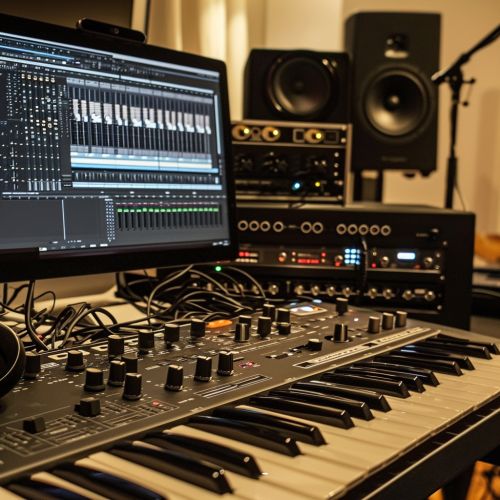Digital audio workstation
Introduction
A Digital Audio Workstation (DAW) is an electronic device or application software used for recording, editing, and producing audio files. DAWs come in a wide variety of configurations from a single software program on a laptop, to an integrated stand-alone unit, all the way to a highly complex configuration of numerous components controlled by a central computer. Regardless of configuration, modern DAWs have a central interface that allows the user to alter and mix multiple recordings and tracks into a final produced piece.


History
The development of digital audio workstations was influenced by advances in computing technology such as faster processors, larger memory storage, and data backup. Early attempts at digital audio workstations in the 1970s and 1980s faced limitations such as the high price of storage, and the vastly slower processing and disk speeds of the time. In 1978, Soundstream (who had made one of the first commercially available digital audio tape recorders in 1977) built what could be considered the first digital audio workstation using some of the most current computer hardware of the time. The Digital Editing System, as Soundstream called it, consisted of a DEC PDP-11/60 minicomputer interfaced with a custom analog-to-digital converter and a disk drive to record its output. This system had 16-bit, 50.4 kHz digital audio, and an editing interface that was far ahead of its time in its precision and flexibility.
Components
A digital audio workstation consists of four basic components: a computer, a sound card (also known as an audio interface), digital audio workstation software, and an input device for adding music or sound. The computer is the core of the workstation. It is responsible for running the DAW software, storing session files, and processing audio. The sound card or audio interface converts analog audio signals into digital data for the computer to process, and converts digital data back into analog signals for playback or recording. The DAW software controls the entire system and is used to record, edit, and mix audio. The input device can be any musical instrument or sound-producing object that can be connected to the computer.
Software
DAW software is the heart of a digital audio workstation. It provides the user interface and controls for recording, editing, and mixing audio. There are many different DAW software programs available, each with its own unique features and capabilities. Some of the most popular DAW software programs include Pro Tools, Logic Pro, Ableton Live, and Cubase. These programs provide a wide range of tools for audio production, including multitrack recording, MIDI sequencing, audio editing, signal processing, and virtual instruments.
Hardware
In addition to the computer and software, a digital audio workstation also requires certain hardware components. The most important of these is the audio interface, which is responsible for converting analog audio signals into digital data for the computer to process, and converting digital data back into analog signals for playback or recording. Other important hardware components include microphones for recording vocals and acoustic instruments, MIDI controllers for playing virtual instruments, and studio monitors for accurate playback of audio.
Uses
Digital audio workstations are used in a variety of musical and audio-related fields. They are used in music production, film scoring, sound design, and broadcast production. In music production, DAWs are used to record, edit, and mix music tracks. In film scoring, they are used to create and manipulate the musical score for a film. In sound design, they are used to create and manipulate sound effects and other audio elements. In broadcast production, they are used to record, edit, and mix audio for radio and television broadcasts.
